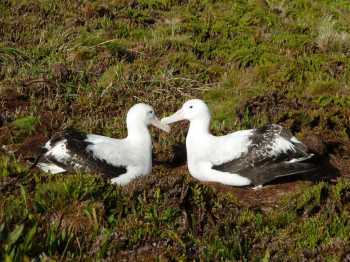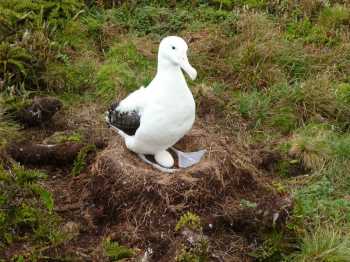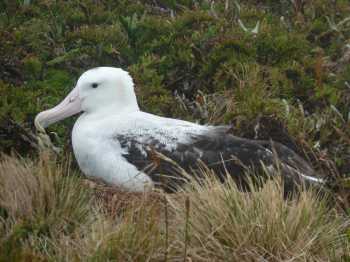The Critically Endangered Tristan Albatross Diomedea dabbenena is endemic to the United Kingdom's Overseas Territory of Tristan da Cunha in the South Atlantic. Practically the whole species' population breeds on Gough Island (where it is seriously at risk from introduced mice), with that of the main island of Tristan long extinct. However, a tiny remnant population continues to cling on to Inaccessible Island, although the last documented breeding attempt on this little-visited island was back in 2000, when just one breeding pair was present.
In early 2009 a single bird was seen displaying on an empty nest on the island. Later in the year but in the next season a male was seen on an empty nest. However, timing and duration of these two visits was such that breeding in both seasons could have occurred but have gone unrecorded.
Confirmation that the Tristan Albatross still breeds on Inaccessible now comes from visits made this year by RSPB Project Officer Katrine Herian and Lourens Malan, both currently working with the Tristan Conservation Department.
During a six-day visit in February five Tristan Albatrosses were observed on the ground on the island's plateau. A courting pair was observed at an empty nest on the slopes of Cairn Peak. Most importantly, a banded bird (J-12652; deemed to be a male from its photograph, see below) was incubating an egg on Gony Ridge. A fifth bird was sitting nearby.
 .
.
The Tristan Albatross pair on Cairn Peak, February 2011. The male is thought to be the bird on the right, the female on the left. Photograph by Lourens Malan


The incubating pair on Gony Ridge. The top banded bird is the assumed male, photographed in February, the bottom unbanded bird the female, photographed in March. Photographs by Katrine Herian and Lourens Malan
J-12652 was banded on Inaccessible on 30 December 1999, sitting on an empty nest on the north side of Gony Ridge, by Peter Ryan of the University of Cape Town's FitzPatrick Institute.
On a return visit on 15 March the unbanded assumed female of the pair was incubating. A post-winter visit is planned to follow the fortunes of this single breeding attempt, the first definite record for Inaccessible Island for more than a decade, and to band the chick if present.
Given the now well-known effects of mice on Gough's Tristan Albatross chicks, it is absolutely critical that World Heritage Inaccessible Island remains rodent-free, and so keeping to best-practice biosecurity procedures during all landings made is of paramount importance. This includes during visits being made right now in regard to the Nightingale oiling disaster.
Click here to access the new management plan and the bird monitoring manual for Inaccessible Island.
With thanks to Katrine Herian and Peter Ryan for information.
John Cooper, ACAP Information Officer, 5 April 2011

 English
English  Français
Français  Español
Español